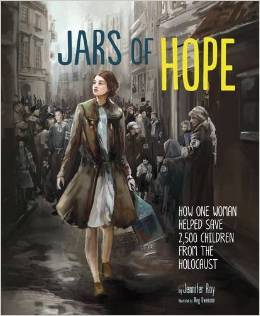
I seem to be reading a lot of World War II and Holocaust books lately. This one caught my attention because I heard about it in a webinar on nonfiction for children and young adults. Finding nonfiction about these topics that are age-appropriate for elementary school students can sometimes be difficult, so I was especially pleased to see a picture book account of Irena Sendler's efforts to save Jewish children from the Warsaw Ghetto during the Nazi occupation of Poland.
As a social worker, Irena was able to come and go from the Ghetto and make contact with families there. Together with other brave people in Warsaw, she helped to smuggle hundreds of infants and children to safety with foster families, orphanages, and convents. Although she was caught and held for questioning for 3 months by the Gestapo, Irena never betrayed her friends or the locations of the children. Her "jars of hope" were jars buried in the backyard that contained the detailed lists she had made of each child's true name, their new alias, where they had been placed, and the names of their parents. With this information, children whose families had survived the war were able to be reunited with their loved ones.
Children sometimes think that heroes can only be male, or very physically strong, or good fighters. They don't understand that heroes come in all shapes and sizes and genders, or that violence isn't the only way to "fight" against evil. Stories of real-life heroes and heroines such as Irena Sendler need to be included in library collections and classroom lessons so that students can experience them and find inspiration.
I read an e-book provided by the publisher through NetGalley.
No comments:
Post a Comment